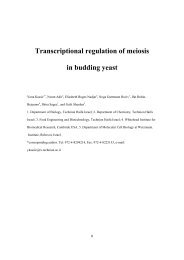Ab Initio Study of Silyloxonium Ions
Ab Initio Study of Silyloxonium Ions
Ab Initio Study of Silyloxonium Ions
You also want an ePaper? Increase the reach of your titles
YUMPU automatically turns print PDFs into web optimized ePapers that Google loves.
<strong>Ab</strong> <strong>Initio</strong> <strong>Study</strong> <strong>of</strong> <strong>Silyloxonium</strong> <strong>Ions</strong> Organometallics, Vol. 16, No. 26, 1997 5949<br />
Table 9. Relative Proton Affinities and Basicities <strong>of</strong> Siloxanes in Cyclohexane and Dichloromethane<br />
Calculated Using the IPCM Model<br />
solvent (ɛ) µ (D) -Es el (hartrees) Eg el - Es el (kcal/mol) ∆(∆Hprot,s) (kcal/mol) ∆(∆Gprot,s) (kcal/mol)<br />
4a<br />
4b<br />
C6H12 (2.0) 0.16 656.259 02<br />
656.561 23<br />
0<br />
31.8<br />
0 0<br />
5a 0 1 095.121 24 2.1 -5.3 -1.2<br />
5b 1 095.425 14 30.2<br />
6a 0 1 460.175 69 0.2 -1.9 -3.2<br />
6b 1 460.482 87 27.7<br />
7a 1.84 733.179 09 1.4 7.3 8.7<br />
7b 733.548 44 29.8<br />
4a<br />
4b<br />
CH2Cl2 (8.9) 0.19 656.260 77<br />
656.655 00<br />
1.1<br />
58.8<br />
0 0<br />
5a 0.09 1 095.130 32 5.7 -7.3 -3.2<br />
5b 1 095.516 35 57.2<br />
7a 2.24 733.182 31 3.4 4.8 6.2<br />
7b 733.588 92 55.2<br />
indeed found for D4. 3 These conclusions correspond well<br />
to the observed features <strong>of</strong> dihydrogen siloxane equilibration.<br />
3f,7 The order <strong>of</strong> the reactivities predicted on this<br />
basis, 7a > 5a > 6a, is the same as that observed for<br />
the dimethylsiloxane analogues.<br />
The relatively low basicity and silicophilicity <strong>of</strong> cyclotrisiloxane<br />
5a and the relatively high strain energies<br />
<strong>of</strong> 5b and 5c imply that the equilibrium constants for<br />
silyloxonium ions formation are small and therefore the<br />
stationary concentration <strong>of</strong> the silyloxonium species in<br />
the polymerization <strong>of</strong> 5a is predicted to be very low.<br />
From this it is possible to conclude that the alternative<br />
pathways <strong>of</strong> propagation (not involving silyloxonium<br />
ions), such as insertion <strong>of</strong> the monomer into the activated<br />
ester end group, can compete effectively with the<br />
silyloxonium pathway. 3 In contrast, the ring strain in<br />
7a is released upon silyloxonium ion formation; therefore,<br />
the stationary concentrations <strong>of</strong> the oxonium ions<br />
7b and 7c are expected to be relatively high. Various<br />
acid-base equilibria, which complicate the polymerization<br />
<strong>of</strong> D3 and D4 because <strong>of</strong> the low basicity <strong>of</strong> these<br />
monomers. 3d,e,29b should be less important in the case<br />
<strong>of</strong> the more basic oxadisilacyclopentane. The kinetics<br />
<strong>of</strong> polymerization <strong>of</strong> this monomer should therefore be<br />
simpler and should resemble the kinetics <strong>of</strong> polymeri-<br />
(34) Cypryk, M. Proceedings <strong>of</strong> the International Polymer Seminar;<br />
W. SÄ wie¸tosławski Foundation for the Promotion <strong>of</strong> Science in Poland:<br />
Gliwice, Poland, 1996; p 45.<br />
(35) Chase, M. W., Jr.; Davies, C. A.; Downey, J. R., Jr.; Frurip, D.<br />
J.; McDonald, R. A.; Syverund, A. N. J. Phys. Chem. Ref. Data 1985,<br />
14, S1.<br />
zation <strong>of</strong> THF. Preliminary data from the Łódz´ laboratory<br />
on the polymerization <strong>of</strong> oxatetramethyldisilacyclopentane<br />
indeed confirm these predictions. 34<br />
The calculations in solution reveal also some variations<br />
in ring strain energies due to different energies<br />
<strong>of</strong> interaction with solvent. Thus, the HF/6-31G* strain<br />
energy <strong>of</strong> 5a calculated from eq 4 decreases from -26.4<br />
kcal (6.6 kcal/mol) in the gas phase to -18.7 kcal (4.7<br />
kcal/mol) in cyclohexane.<br />
Another important finding <strong>of</strong> the calculations is that<br />
nucleophilic attack on a silylated cyclosiloxane 5c or 7c<br />
is predicted to cleave the endocyclic Si-O bonds more<br />
easily than the exocyclic Si-O bond. This expected to<br />
favor ring opening and propagation over transfer <strong>of</strong> the<br />
exocyclic H3Si + group to another molecule <strong>of</strong> monomer<br />
or to an oxygen in a chain.<br />
Acknowledgment. This work was supported by the<br />
German Federal Ministry for Science, Research, Technology<br />
and Education (BMBF) and the Minerva Foundation<br />
in Munich. The financial support for a travel<br />
grant to M.C. from the Israeli Academy <strong>of</strong> Sciences and<br />
Humanities is gratefully acknowledged. We thank Dr.<br />
Miriam Karni and Michael Bendikov (Technion) for<br />
helpful discussions.<br />
Supporting Information Available: Table 10, giving the<br />
absolute energies <strong>of</strong> calculated species (1 page). Ordering<br />
information is given on any current masthead page.<br />
OM9701128













